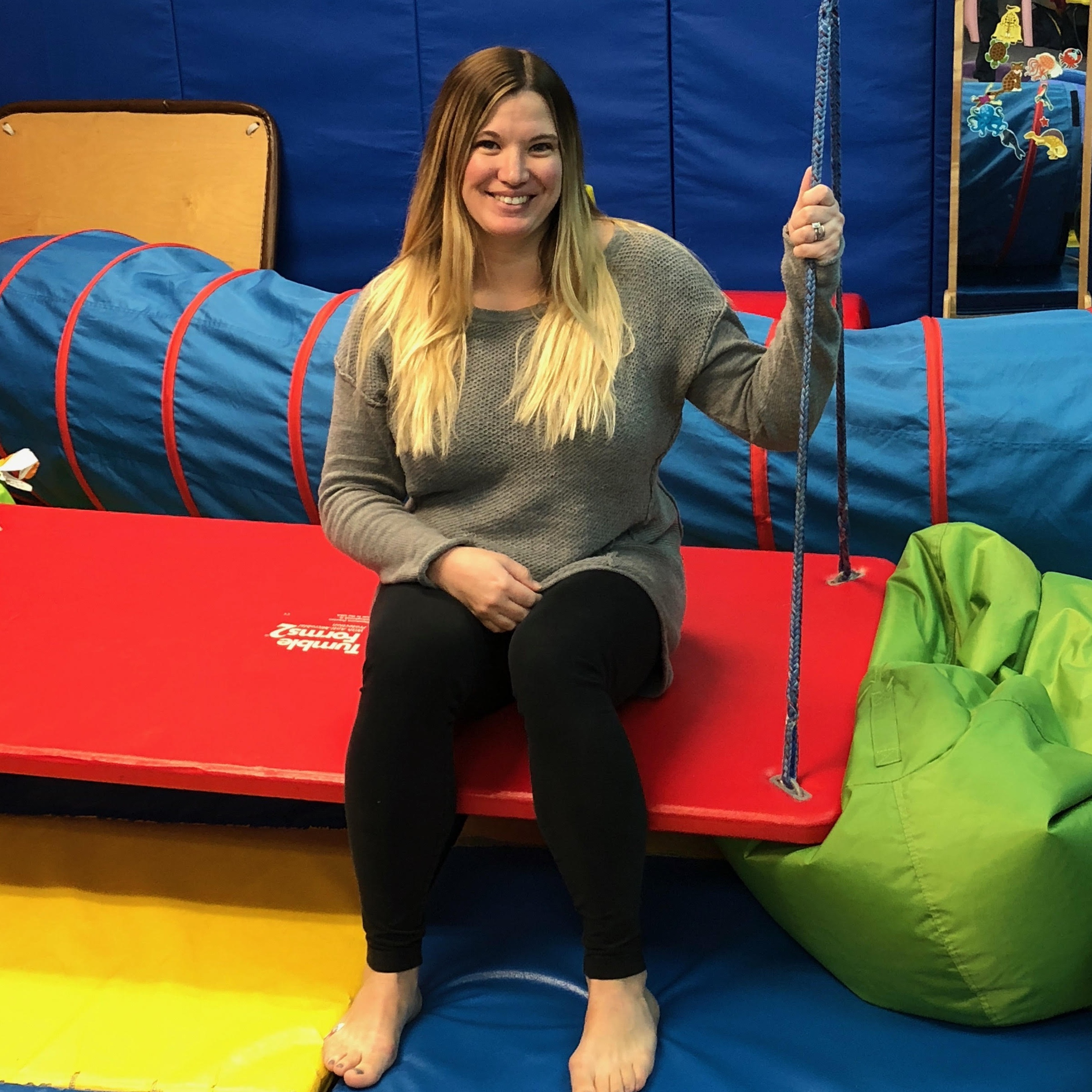
Written by Zach Grossfeld
Jennifer Link Cody wants children to have the best possible tools at their disposal to tackle life. Whether she’s working during the day as an occupational therapist or spending time with her own kids at home, she has a profound impact on the growth and development of children. Here’s a look into the life of Jenn Link and some of the challenges she faces on a daily basis.
In The Gym
“I was always passionate about working with children,” says Jenn. “I value movement and play.” Jennifer Link Cody, an occupational therapist and supervisor at All About Kids, did not pursue a career in therapy until years after college. She coached gymnastics out of school. In a managerial role, Jenn wrote lesson plans, trained new employees, and got to know the parents.
Working with kids of all ages, she taught many who had special needs. She spoke closely with one parent, learning about her daughter’s sensory issues and need for therapy. “I coached private gymnastic lessons with this girl and became fascinated by sensory processing after talking with her mother,” says Jenn. “Seeing children with special needs in a mainstream class, sometimes struggling, made me want to understand more.”
Soon after, Jenn went back to graduate school for occupational therapy. “I was splitting time between teaching gymnastics in Westchester and the Upper East Side, and full-time classes at Mercy College,” she says. Upon graduation, Jenn took a job at All About Kids as a staff therapist. The clinical fieldwork she completed in school drew upon her gymnastics background. “When I first interviewed at All About Kids and saw the gym, I felt at home”, she says.
Becoming a Kid Again
Working as a full-time therapist requires a high level of energy and intense time management. “Every minute is accounted for,” says Jenn. “We treat anywhere and everywhere.” Therapists drive to daycares, children’s homes, preschools, and work with kids in the clinic. In between cases, they type out notes and talk to teachers and parents. “We have to make sure everyone is on the same page about the child,” says Jenn. Meetings can be over the phone to save time, but may need to be in person.
When therapists aren’t updating parents between cases, they are maximizing rare downtime. Jenn researches new treatments and models of care to stay on top of changing technology. She incorporates new toys, sets up obstacles courses, and writes out treatment plans. “I’m always on the move,” says Jenn. “It’s not uncommon for therapists to eat lunch in their car to save time.”

In a session, therapists embrace the child’s mindset. “I go into their world without forcing them to go into ours,” says Jenn. “Every child is different.” A therapist plays and makes sense of the surroundings from a child’s perspective. Rolling on the floor, sitting cross-legged, and laying down helps Jenn interact at eye level. “Sometimes, it may take a while to build rapport and trust. If they’re nervous or anxious, I may just sit under the table with them until they begin to open up,” she says. “You have to become a kid again.”
Discharging a child can be difficult for both the child and the therapist. An emotional bond builds through each session. “It’s exciting of course, but can be bittersweet when a child leaves,” says Jenn. “They don’t need you anymore, but they are off to face new challenges.” Many therapists stay in contact with parents.
Part of a therapist’s role involves preparing the parents for the child’s life beyond therapy. A child-centered, family-focused, plan of care helps the child adjust. “Sometimes, I’ll run into parents or they’ll send me a quick email with an update,” she says. “It brings tears to my eyes hearing stories of their child’s progress once they leave.”
In therapy, progress unfolds in small steps. A child writing their name without help, not having a meltdown at a birthday party, or sitting up straight in a chair for two minutes signifies immense leaps in development. “Working with special needs kids, the big things are the small things,” says Jenn. “Some days it can be as simple as a child not crying when they see me,” she laughs.
Motherhood
Outside of her own sessions, Jenn supervises the other therapists. Therapists work long hours, sometimes beyond 8 am to 6 pm; most therapists do not have a free moment to check in with Jenn until nighttime. “I’ve been in the same position, so I understand their schedule,” she says. “A lot of times I’m up late at night addressing issues therapists are having.” On the flip side, if Jenn reaches out to a therapist, many times she won’t receive a response until after 6 pm.
“The hours are a struggle,” she says. Even with the intense time commitment, Jenn always looks to learn from her peers in the field. “The therapists I supervise constantly teach me things,” she says. “I am always watching what they do with the kids.”
Aside from working with kids and prepping for sessions, therapists spend hours on paperwork. An average caseload hovers around 25-35 kids, usually seen twice per week. A note is required for each session. Therapists do not receive extra compensation for any paperwork. “The notes aren’t complicated, but it takes time to fill out each one,” says Jenn. “A few minutes here and there starts to add up.”
A therapist also does not earn extra pay for phone calls, texts, or emails with teachers, parents, and providers. Treating a child who needs four related services, the therapist must make and maintain all lines of communication for each service.
“The nice thing about being in a clinic is that it’s easier to chat with providers in the office rather than make a call,” says Jenn. “But a lot of times that’s not the case.” A parent forgetting to cancel a session, a progress report due, or an annual review all chip away from the time a therapist can be spending with a child. “People don’t always realize the things that need to get done,” she says. “There is a constant to-do list.”
For Jenn, the hardest part is the balance. As a therapist and a mother, she survives on preparation and time management. “I constantly have this battle of am I doing enough for my own kids, for the children I treat, for the therapists?” says Jenn. “If the answer is no, when will I get the time to do better?” Taking a step back helps refocus perspective. Progress cannot be made as a parent or a therapist without a mutual comfortability.
“Children need a break sometimes too,” she says. “I’ll feel burnt out, but then I remember that this child may have three different therapists demanding things from them.” Reverting to square one can instill newfound energy into a session. “Some days we won’t work on something I planned if a kid looks stressed,” she says. “Sometimes we’ll just play.” Therapists know the power and therapeutic benefits of play.
Bouncing ideas off other therapists, Jenn relates through experience. Speaking with others in the field helps keep things in perspective. “Did you get spit on today? Did someone wipe snot on your shirt? We’ve all been through it,” she laughs. Hanging around the newer therapists exposes her to the latest techniques and technology. As a supervisor, Jenn stays open to learning from the next generation of therapists. “Sometimes I get so immersed in what I’m doing that I feel stuck, like why am I doing this? Is this right?” She says. “Asking questions can lead you to something new and can help you move beyond that feeling.”
Always Ask
In her earliest days as a therapist, Jenn wishes she had asked more questions. At times, she hesitated to ask for help. “Questions aren’t a sign of weakness. It’s the only way to get the information you need.” Gathering information from more experienced minds bolsters the confidence needed in the field.
Navigating interactions between parents, teachers, and other professionals can be challenging. There needs to be clear communication and expectations while always being positive and respectful. “I tell therapists, especially newer ones, all the time: You are the expert at what you do. The parent is the absolute expert on their child, but YOU are the expert in OT,” says Jenn. Confidence in yourself breeds confidence with others.
Down the road, Jenn hopes to create a platform giving wider access to activities, services, and amenities for the children who need it. Typically, a child qualifies for two sessions per week for each service. Sessions are usually thirty minutes. After that, responsibility switches to the parents. Simple, everyday tasks can become nightmares for families who have children with special needs.
More activities, like special movie viewings or visits with Santa, need to cater to all kids, including those with special needs. “What’s available for these parents and kids outside of therapy, outside of school?” she asks. “We need a mainstream, educational platform to bring more awareness to the public. Many times, there are easy adjustments and accommodations to make activities enjoyable for everyone. I’d love to be able to help that happen.”








